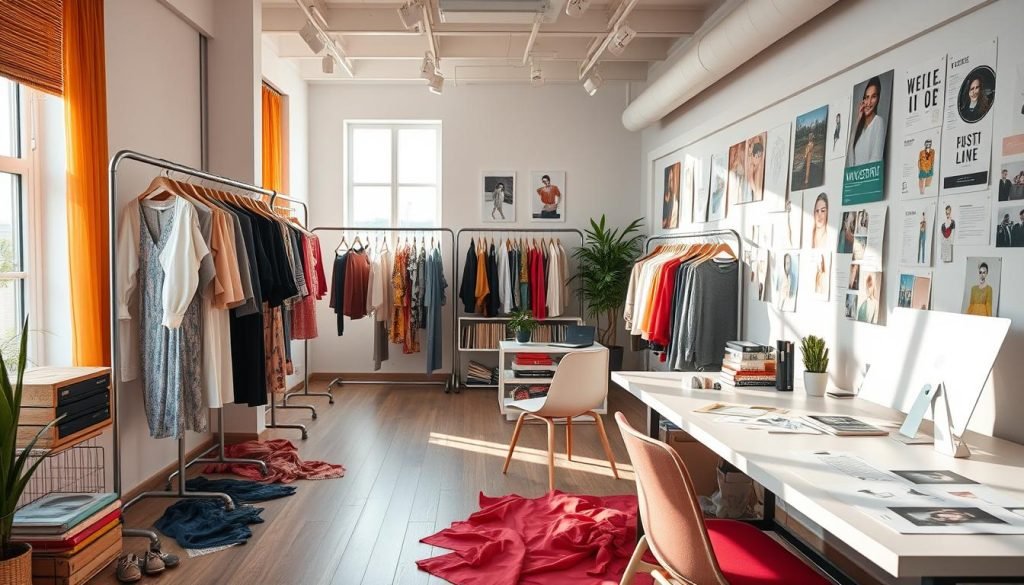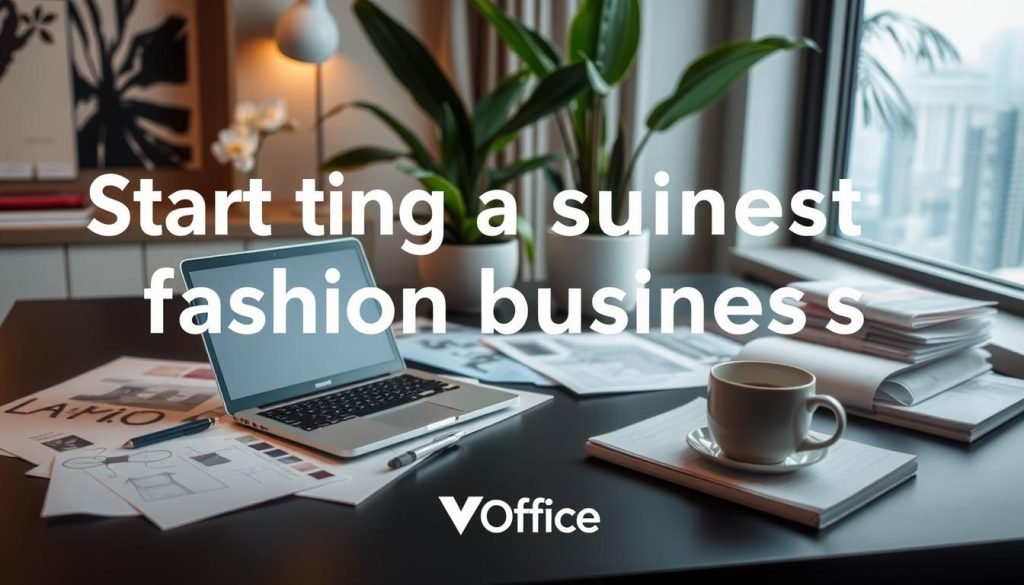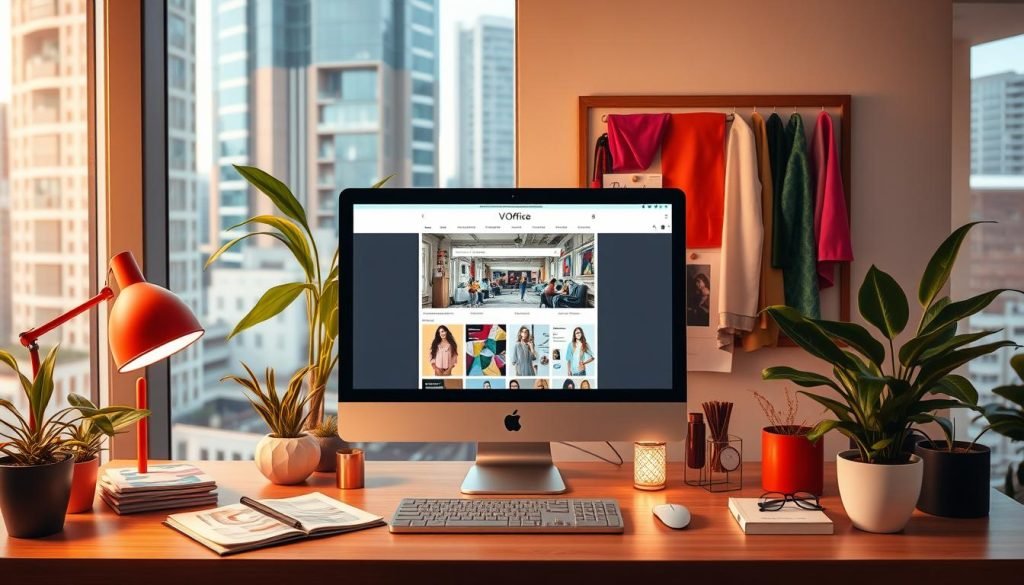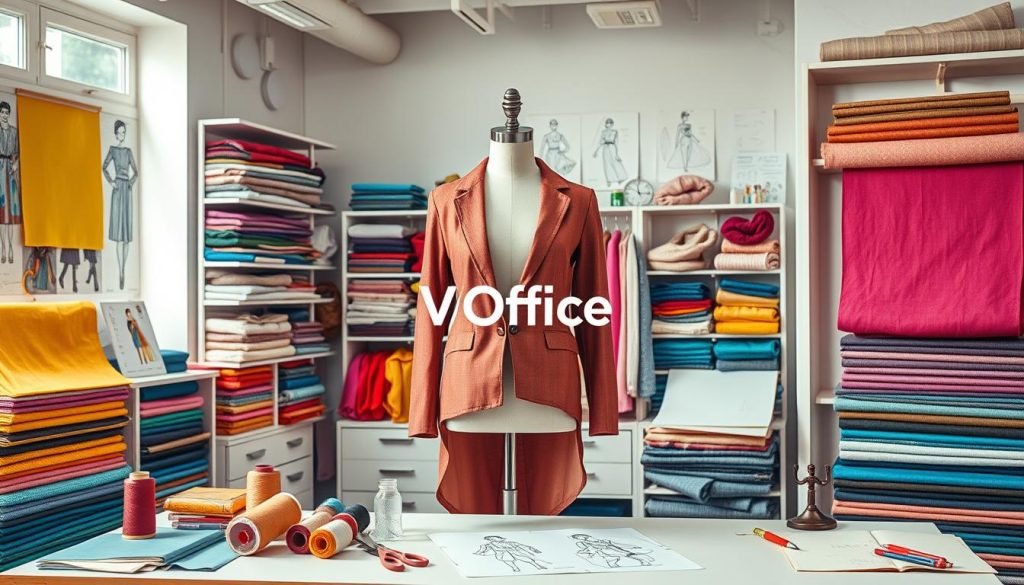Starting a clothing brand in Singapore is a great chance in a lively fashion scene. The fashion industry is expected to grow to USD 2.3 billion by 2025. This makes it a perfect time for entrepreneurs to jump in.
Events like Singapore Fashion Week highlight local talent. The support system is strong, with easy entry barriers. These factors make it a great time to start a fashion business.
This guide gives you key fashion entrepreneurship tips for the Singapore market. It’s important to know the local culture and design tastes to succeed. Get ready for a journey full of learning and growth as we help you succeed in the fashion world.
Why Start a Fashion Business in Singapore
Singapore is a great place for starting a fashion business. It has a growing interest in local designs. This shows there are many opportunities for new entrepreneurs.
With a fashion-loving population and a growing market, starting a boutique here can be very rewarding. It can also be profitable.
Understanding the Growing Market Demand
There’s a shift in what people want to buy. Now, there’s more interest in unique, local clothes as big European brands lose popularity. People here have a lot of money to spend on good clothes.
This trend offers a chance for entrepreneurs to make a successful business. They just need the right brand and plan.
The Influence of Local Culture on Fashion Trends
Local culture plays a big role in fashion in Singapore. The mix of different cultures creates a unique style. This makes fashion a way for people to express themselves.
Starting a fashion business here means connecting with these cultural stories. Singapore is also a key place for fashion events and trade shows. This gives new businesses a chance to grow and meet others in the industry.

Key Characteristics of a Successful Fashion Business
Success in fashion needs creativity and business smarts. Those starting a fashion brand must know their audience and let their unique style stand out. A strong brand identity is key to standing out from others.
Balancing Creativity and Business Acumen
Starting a fashion company means working in both the artistic and business worlds. A good entrepreneur should have:
- Industry Knowledge: 70% of successful fashion entrepreneurs know the market well and its trends.
- Communication Skills: 85% say good negotiation skills are important for working with buyers, suppliers, and the team.
- Marketing Proficiency: 60% use strong marketing to reach their target audience.
- Technological Savviness: 50% use online platforms for marketing and making money.
The Importance of Unique Brand Identity
Having a unique brand identity is key in a crowded market. Leaders like Marc Jacobs and Michael Kors show that sticking to core values and a clear vision is vital for lasting success.
| Characteristic | Percentage of Successful Entrepreneurs |
|---|---|
| Creativity and Innovation Skills | 75% |
| Confidence and Self-Belief | 80% |
| Ambition and Drive | 90% |
| Basic Financial Management Skills | 40% |
| Photography Skills | 30% |
| Understanding of Technology | 65% |

Starting a Fashion Business: Essential Steps
Starting a clothing brand takes careful planning and execution. Entrepreneurs need to focus on two key areas: building a strong business model and making a detailed business plan. These steps are crucial for success in the fashion industry.
Developing Your Business Model
Understanding your business model is key when starting a clothing line. You need to decide if you’ll make clothes by hand, work with manufacturers, or use print-on-demand services. Each option has its pros and cons, affecting your costs, pricing, and where you stand in the market.
Creating a Comprehensive Business Plan
A detailed business plan is vital for your clothing business. It outlines your brand’s goals, who you’re selling to, and your financial forecasts. Begin by researching the market to make sure your products appeal to customers. Add sections on marketing, design, and how you’ll get your clothes to customers. Important points to cover include:
- Funding sources like personal savings, family, and friends, as well as potential angel investors.
- Choosing legal structures such as LLCs or partnerships that suit your business.
- Marketing strategies, including both organic methods and paid social media ads.
- Your unique selling point to stand out in a crowded market.
Legal Requirements for Starting a Fashion Business in Singapore
Starting a fashion business in Singapore means you need to know the legal stuff. You must choose the right business structure. This choice affects how you register with ACRA and follow the law. Knowing this helps set up your business for success.
Understanding Business Structures
Most people start with a private limited company in Singapore. This type protects your personal stuff from business debts. You can also look into sole proprietorships or partnerships, but think about how they fit with your business goals.
Registration Processes with ACRA
Registering with ACRA is pretty easy. It usually takes about 1.5 hours. You’ll need things like the company’s rules, a list of directors, and meeting minutes. Getting this done fast lets you focus on growing your fashion brand.

Obtaining Necessary Licenses and Permits
You’ll need different licenses and permits for your fashion business. This depends on what you do. For example, if you’re importing or exporting, you’ll need special licenses. Knowing what you need helps you avoid legal trouble and run smoothly.
Building Your Brand and Marketing Strategy
Starting a fashion business is more than just designing clothes. It’s about having marketing strategies for fashion that speak to your audience. A strong brand identity is key. Begin by establishing a strong online presence. This means having a professional website and an e-commerce platform to show off your products. It also helps you talk to potential customers.
Establishing a Strong Online Presence
Creating a solid online base is the first step in building a fashion brand. The global fashion eCommerce market is set to hit $1.2 trillion by 2027. A good website makes shopping easy and fun, which matters a lot since 86% of customers are willing to pay more for great service. Also, having a mobile-friendly design helps with the rise of smartphone shopping.
This approach lets brands reach more people and make shopping smooth. It’s a way to grow your customer base.
Utilizing Social Media for Promotion
Social media is key for promoting brands. Using Instagram, Facebook, and TikTok can really engage your audience with great visuals. These sites let fashion entrepreneurs share their stories, connect with customers, and highlight what makes them special.
By telling stories through visuals, you can make a deep connection with potential buyers. This can lead to more sales. Social media also lets you talk to your audience, get feedback, and build a community. All these things help make your brand more loyal.

Sourcing Materials for Your Fashion Business
To succeed in the fashion industry, finding the right materials is key. Entrepreneurs need to find suppliers who match their quality and values. Working with both local and international suppliers helps keep a steady supply chain and supports growth.
Identifying Reliable Suppliers
Being clear is crucial when picking suppliers. Clients often ask for something general like cotton fabric, which might not work well. Suppliers like specific requests. By asking for what you really need, you can get better results. Here are some tips for finding reliable suppliers:
- Research and Due Diligence: Look into suppliers’ reputations by reading reviews and testimonials.
- Request Samples: Check the quality of materials with samples before ordering a lot.
- Price and Availability: Look at prices and see if suppliers can meet your order size.
- Communication: Keep talking to suppliers to quickly solve any problems.
Considerations for Sustainable Sourcing
Now, sustainable sourcing is a big deal in fashion, thanks to more eco-conscious consumers. Brands are finding new ways to source sustainably, which helps their image and attracts customers. Here are some important points to think about:
- Material Selection: Pick materials that are organic or recycled to lessen harm to the environment.
- Supplier Practices: Work with suppliers who are ethical and responsible.
- Local Sourcing: Buying materials locally helps the local economy and cuts down on emissions from shipping.
- Circular Fashion: Use methods that encourage a circular economy, like making things reusable and recyclable.

The way we source materials is always changing, thanks to new trends, tech, and what consumers want. Keeping up with these changes and being flexible in sourcing helps entrepreneurs stay ahead. By focusing on quality and being eco-friendly, businesses can do well in a market that cares more about the planet.
Production and Manufacturing Strategies
As fashion brands grow, they face a big decision: what production strategy to use. They must choose between making clothes themselves or working with others. Each choice has its own pros and cons, affecting costs, quality, and efficiency.
Choosing Between In-House Production and Outsourcing
For new fashion brands, deciding between in-house and outsourcing is key. In-house production means you control the making of clothes. This lets brands use custom solutions and work closely with suppliers. Outsourcing can save money by using big manufacturers’ scale. Here’s a quick look at the differences:
| Factor | In-House Production | Outsourcing |
|---|---|---|
| Cost | Higher initial costs; potential long-term savings | Lower initial investment; potential hidden costs |
| Quality Control | Direct oversight; easier to enforce standards | Dependent on manufacturers; requires stringent oversight |
| Lead Times | More predictable if well-managed | May vary based on manufacturer’s schedule |
| Flexibility | More adaptable to changes | Potentially less responsive to market shifts |
Establishing Quality Control Measures
Good quality control is key, no matter the production method. It ensures products meet and beat customer expectations. This focus on quality builds brand loyalty, which is vital for success in fashion.
Here are ways to keep quality up:
- Regular inspections during production
- Clear quality standards that match brand values
- Using advanced tech for production checks
- Feedback systems to quickly address customer issues
Setting Pricing Strategies for Success
In the fashion industry, setting the right prices is key to making money. Entrepreneurs need to look at more than just production costs. They should also think about shipping, marketing, and tech packs. For example, a bridge brand might start prices at £140 for hoodies, £135 for joggers, and £60 for t-shirts. This way, they cover costs and make their products stand out.
Calculating Costs and Profit Margins
When setting prices, it’s important to analyze production costs. This includes things like sampling, making clothes in bulk, cutting patterns, and shipping times. Shipping can take 5-6 weeks by sea or be quicker but more expensive by air.
Pricing affects how much money you make and how people see the value of your products. Items priced higher are often seen as better quality. Starting with a higher price can help you offer discounts later without losing money.
Adjusting Prices for Different Market Demographics
Knowing who you’re selling to is key to setting the right prices. Fashion retailers change prices based on what people want, trends, and the season. Brands that offer value or luxury need to adjust their prices to match their market and brand image.
With help from experts like Hook and Eye UK, fashion business owners can make their pricing work better. They can make more money and keep up with changes in their customers’ needs.
FAQ
What are the essential steps for starting a fashion business in Singapore?
How do I create a unique brand identity for my clothing line?
What legal requirements do I need to fulfill to launch my fashion startup?
How important is sustainability in the fashion industry?
What are some effective marketing strategies for my fashion business?
How can I calculate pricing strategies for my clothing brand?
Should I produce my clothing line in-house or outsource manufacturing?
How can I identify reliable suppliers for my fashion business?
What are the key characteristics of a successful fashion business?
Source Links
- https://www.singaporesetupcompany.com/blog/creating-a-clothing-business-in-singapore/
- https://heysara.sg/starting-a-retail-business-in-singapore/
- https://blog.storeya.com/2018/02/successful-online-clothing-business/
- https://www.3ecpa.com.sg/resources/industry-guide/starting-a-clothing-business-in-singapore/
- https://startupfashion.com/why-singapore-could-be-the-perfect-place-to-launch-your-brand-in-southeast-asia/
- https://www.herworld.com/pov/the-truth-about-running-a-small-business-in-singapore
- https://www.jameshillman.co.uk/blog/2021/1/24/the-fashion-entrepreneur-skills-you-need-in-2022
- https://www.linkedin.com/pulse/7-defining-qualities-successful-fashion-entrepreneur-maria-pesin
- https://www.forbes.com/advisor/business/start-a-clothing-business/
- https://upmetrics.co/start-business/clothing-line
- https://www.growthink.com/businessplan/help-center/how-to-start-a-fashion-business
- https://www.workstore.com.sg/setting-up-your-clothing-business-online/
- https://www.pilotoasia.com/guide/business-licenses-singapore
- https://www.shopify.com/blog/206934729-how-to-start-a-clothing-line
- https://www.appnova.com/marketing-strategies-for-fashion-brand/
- https://www.shopify.com/sg/blog/206934729-how-to-start-a-clothing-line
- https://thefashionbusinesscoach.com/blog/sourcingfabrics
- https://www.lal10.com/blogs/sourcing-strategies-in-the-fashion-industry
- https://www.uphance.com/insights/make-to-order-production/
- https://sewport.com/cut-and-sew-manufacturers
- https://www.joininflow.io/vi/blogs/shein-and-on-demand-manufacturing-revolutionizing-the-fast-fashion-industry
- https://hookandeyeuk.com/blogs/news/fashion-pricing-strategy-how-to-price-your-clothing-brand?srsltid=AfmBOoqXAOyHWRuq_eN5Be4pUyunCNylmeDwixqlla__skb2Af5Uih83
- https://www.oracle.com/sg/retail/fashion/fashion-pricing-strategy/

